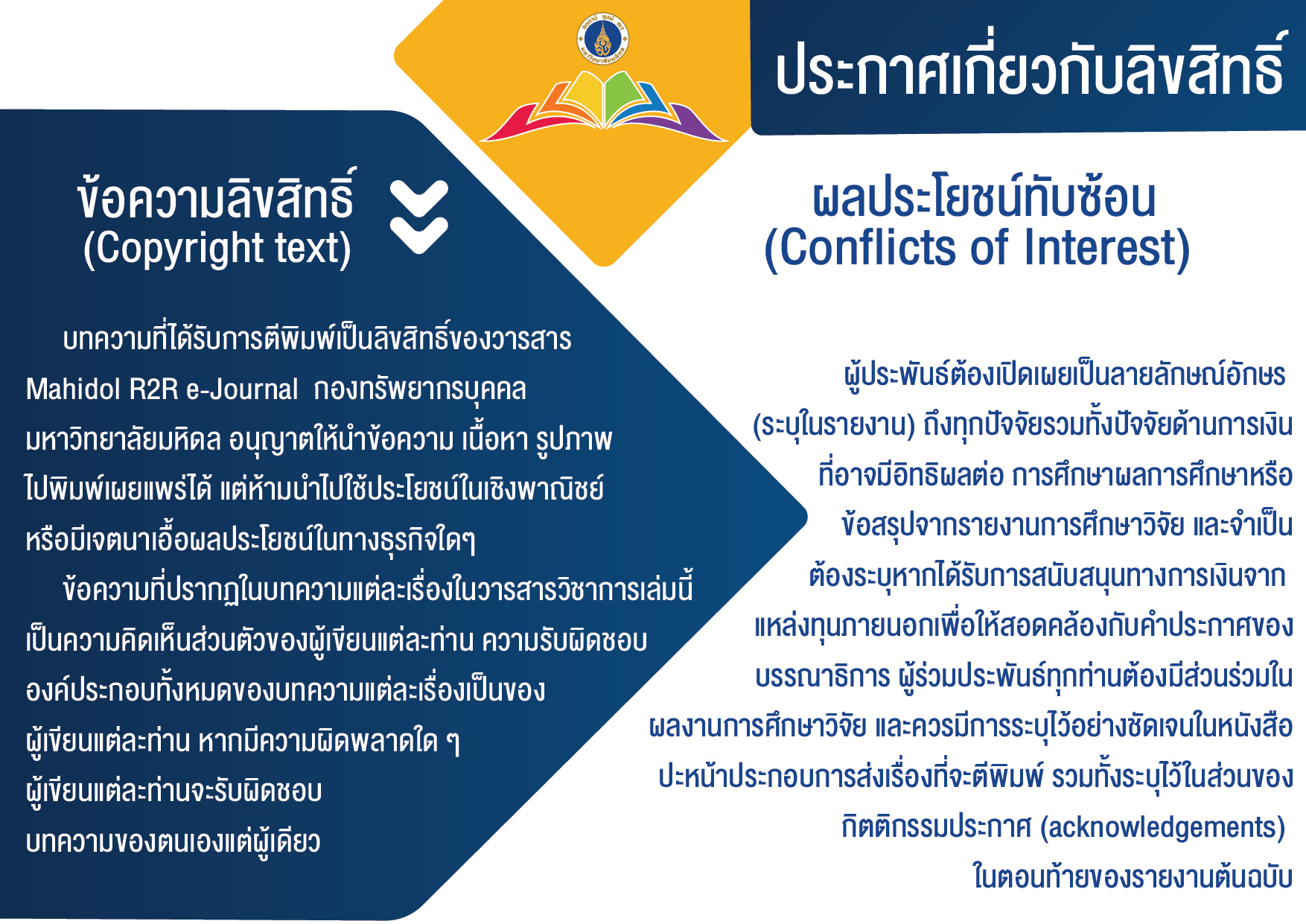การศึกษาตัวทำละลายที่เหมาะสมสำหรับการละลายไทมอลเพื่อใช้ในทางทันตกรรม
DOI:
https://doi.org/10.14456/jmu.2024.25คำสำคัญ:
ไทมอล, การละลาย, การใช้ในทางทันตกรรมบทคัดย่อ
ไทมอลมีฤทธิ์ต้านจุลชีพอย่างกว้างขวาง จากคุณสมบัติทางชีวภาพดังกล่าว คณะทันตแพทยศาสตร์ มหาวิทยาลัยมหิดล จึงนำมาเตรียมเป็นผลิตภัณฑ์ไทมอลความเข้มข้น 0.1% (น้ำหนัก/ปริมาตร) เพื่อเก็บรักษาตัวอย่างฟันสำหรับงานวิจัย เนื่องจากไทมอลละลายน้ำได้ค่อนข้างน้อย การเตรียมผลิตภัณฑ์ดังกล่าวจึงใช้เวลานาน ทำให้เกิดความขาดแคลนผลิตภัณฑ์ในบางช่วงเวลา งานวิจัยนี้จึงมุ่งที่จะลดระยะเวลาสำหรับการเตรียมผลิตภัณฑ์ โดยยังคงคุณสมบัติและตัวยาสำคัญ รวมถึงค้นหาความเข้มข้นที่เหมาะสมของตัวทำละลายสำหรับไทมอล และความเข้มข้นของไทมอลภายหลังการละลาย
การศึกษานี้วิเคราะห์ระยะเวลาสำหรับเตรียมสารละลาย 0.1% ไทมอล และปริมาณที่น้อยที่สุดของ EtOH (55%, 75%, 95% และ absolute) ซึ่งใช้เป็นตัวทำละลายสำหรับไทมอล และใช้เครื่อง High Performance Liquid Chromatography (HPLC) เพื่อหาปริมาณของสารประกอบสำคัญของสารละลายไทมอลปริมาตรน้อยที่สุดสำหรับ EtOH ณ ความเข้มข้นต่าง ๆ ที่ใช้ละลายไทมอลได้อย่างสมบูรณ์ คือ 3 มล. (ต่อปริมาตรรวม 100 มล.) นอกจากนี้การวิเคราะห์ด้วย HPLC แสดงให้เห็นว่า ปริมาณไทมอลในสารละลายที่เตรียมไว้ คือ 0.079%, 0.089%, 0.087%, 0.087% และ 0.086% ของ DIW, 55%, 75%, 95% และ Absolute alcohol ตามลำดับ
สรุปผลงานวิจัย คือ สารละลาย 0.1% ไทมอลที่เตรียมจาก EtOH ความเข้มข้นต่าง ๆ มีปริมาณของไทมอลสูงกว่าแบบที่เตรียมจาก DIW สูตรเตรียมสารละลายไทมอลนี้สามารถนำไปพัฒนาต่อยอด เพื่อนำไปใช้ในอนาคตได้
References
วิพรพรรณ ศรีสุธรรม, ศศิพิมพ์ คำสระ, ปาริชาติ พุ่มขจร และ พงศ์ศักดิ์ รัตนชัยกุลโสภณ. (2561). อิทธิพลของอุณหภูมิต่อความสามารถในการยับยั้งและกลไกการยับยั้ง Escherichia coli O157:H7 โดยไทมอล. วารสารวิทยาศาสตร์และเทคโนโลยี มหาวิทยาลัยอุบลราชธานี, 20(1), 36-43.
Angélica Escobar, Miriam Pérez, Gustavo Romanelli, Guillermo Blustein. (2020). Thymol bioactivity: A review focusing on practical applications. Arabian Journal of Chemistry, 13(12), 9243-9269.
Boutsioukis, C., Psimma, Z., & Kastrinakis, E. (2014). The effect of flow rate and agitation technique on irrigant extrusion ex vivo. International endodontic journal, 47(5), 487–496. https://doi.org/10.1111/iej.12176
Cosentino, S., Tuberoso, C. I. G., Pisano, B., Satta, M., Mascia, V., Arzedi, E., & Palmas, F. (1999). In-vitro antimicrobial activity and chemical composition of Sardinian Thymus essential oils. Letters in applied microbiology, 29(2), 130–135. https://doi.org/10.1046/j.1472-765x.1999.00605.x
Dedić, M., Bečić, E., Imamović, B., Žiga, N., Medanhodžić-Vuk, S., Šober, M. (2018). HPLC method for determination the content of thymol and carvacrol in Thyme tincture. Bulletin of the Chemists and Technologists of Bosnia and Herzegovina, 50, 1-6.
Ferrer-Luque, C. M., Bejarano, I., Ruiz-Linares, M., & Baca, P. (2014). Reduction in Enteroccocus faecalis counts - a comparison between rotary and reciprocating systems. International endodontic journal, 47(4), 380–386. https://doi.org/10.1111/iej.12158
Goodis, H. E., Marshall, G. W., Jr, White, J. M., Gee, L., Hornberger, B., & Marshall, S. J. (1993). Storage effects on dentin permeability and shear bond strengths. Dental materials: official publication of the Academy of Dental Materials, 9(2), 79–84. https://doi.org/10.1016/0109-5641(93)90079-6
Hajimehdipoor, H., Shekarchi, M., Khanavi, M., Adib, N., & Amri, M. (2010). A validated high performance liquid chromatography method for the analysis of thymol and carvacrol in Thymus vulgaris L. volatile oil. Pharmacognosy magazine, 6(23), 154–158. https://doi.org/10.4103/0973-1296.66927
Kokoska, L., Kloucek, P., Leuner, O., & Novy, P. (2019). Plant-Derived Products as Antibacterial and Antifungal Agents in Human Health Care. Current medicinal chemistry, 26(29), 5501–5541. https://doi.org/10.2174/092986 7325666180831144344
Lambert, R. J., Skandamis, P. N., Coote, P. J., & Nychas, G. J. (2001). A study of the minimum inhibitory concentration and mode of action of oregano essential oil, thymol and carvacrol. Journal of applied microbiology, 91(3), 453–462. https://doi.org/10.1046/j.1365-2672.2001.01428.x
Miladi, H., Zmantar, T., Kouidhi, B., Al Qurashi, Y., Bakhrouf, A., Chaabouni, Y., Mahdouani, K., & Chaieb, K. (2017). Synergistic effect of eugenol, carvacrol, thymol, p-cymene and γ-terpinene on inhibition of drug resistance and biofilm formation of oral bacteria. Microbial pathogenesis, 112, 156–163. https://doi.org/10.1016/j.micpath.2017.09.057
Merghni, A., Ben Nejma, M., Dallel, I., Tobji, S., Ben Amor, A., Janel, S., Lafont, F., Aouni, M., & Mastouri, M. (2016). High potential of adhesion to biotic and abiotic surfaces by opportunistic Staphylococcus aureus strains isolated from orthodontic appliances. Microbial pathogenesis, 91, 61–67. https://doi.org/10.1016/j.micpath.2015.11.009
Peters, O. A., Morgental, R. D., Schulze, K. A., Paqué, F., Kopper, P. M., & Vier-Pelisser, F. V. (2014). Determining cutting efficiency of nickel-titanium coronal flaring instruments used in lateral action. International endodontic journal, 47(6), 505–513. https://doi.org/10.1111/iej.12177
Shabir, G. (2004). Step-by-step analytical methods validation and protocol in the quality system compliance industry. Journal of validation technology, 10, 314-324.
Downloads
เผยแพร่แล้ว
ฉบับ
บท
License
Copyright (c) 2024 Mahidol R2R e-Journal

This work is licensed under a Creative Commons Attribution-NonCommercial-NoDerivatives 4.0 International License.



